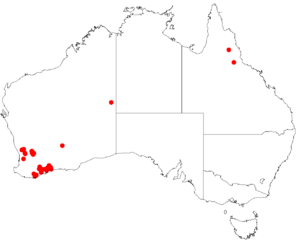Prostanthera canaliculata facts for kids
Quick facts for kids Prostanthera canaliculata |
|
|---|---|
| Scientific classification | |
| Genus: |
Prostanthera
|
| Species: |
canaliculata
|
 |
|
| Occurrence data from AVH | |
| Synonyms | |
|
Prostanthera canaliculata F.Muell. var. canaliculata |
|
Prostanthera canaliculata is a type of flowering plant. It belongs to the Lamiaceae family, which includes mints. This plant is a small, upright shrub. It grows only in the south-west part of Western Australia. Its branches are a bit hairy. The leaves are narrow and shaped like an egg or an ellipse. Its flowers are pale blue, pale violet, or white. They do not have any special markings.
Contents
About the Prostanthera canaliculata Plant
Prostanthera canaliculata is an upright shrub. It usually grows to be about 0.3 to 0.7 meters tall. Its small branches often look whitish. This is because they are covered with many white hairs.
The leaves of this plant are narrow. They can be shaped like an egg or a narrow ellipse. They are also very hairy. Their color can be silvery green or just green. Each leaf is about 4 to 7 millimeters long. They are also about 1 to 1.5 millimeters wide. Some leaves are attached directly to the stem (this is called sessile). Others have a very short stalk, called a petiole, which is up to 0.5 millimeters long.
The flowers grow one by one. They appear where the leaves meet the stem. You can find between two and sixteen flowers near the ends of the branches. Each flower has a tiny stalk, called a pedicel, which is 1 to 1.5 millimeters long.
The green parts that protect the flower bud are called sepals. They have a touch of mauve or purple. These sepals form a tube about 2 to 3 millimeters long. This tube has two parts, or lobes. The lower lobe is 1.5 to 2 millimeters long. The upper lobe is 1 to 1.5 millimeters long.
The colorful parts of the flower are the petals. They are pale blue, pale violet, or white. They do not have any special patterns. The petals are 6.5 to 10 millimeters long. They are joined together to form a tube that is 3 to 7 millimeters long.
The lower part of the flower has three lobes. The middle lobe is shaped like a spatula. It is 3 to 5 millimeters long and 3 to 5 millimeters wide. The two side lobes are 2 to 4 millimeters long and 1 to 3 millimeters wide. The upper part of the flower has two lobes. These are 1.5 to 3.5 millimeters long and 3.5 to 5 millimeters wide. This plant usually flowers from September to November.
Naming and Classification of Prostanthera canaliculata
The scientific name Prostanthera canaliculata was first officially described in 1868. This was done by a scientist named Ferdinand von Mueller. He wrote about it in his book called Fragmenta phytographiae Australiae.
Where Prostanthera canaliculata Grows
This type of mintbush grows in specific areas of Western Australia. It likes sandy hills and flat sandy areas. It can also be found on granite rock outcrops. These places are part of different natural regions. These regions include the Avon Wheatbelt, Esperance Plains, Jarrah Forest, Mallee, and Swan Coastal Plain.
Conservation Status of Prostanthera canaliculata
The Western Australian Government's Department of Parks and Wildlife checks on plants. They have classified Prostanthera canaliculata as "not threatened." This means the plant is not currently at risk of disappearing.

